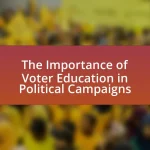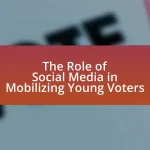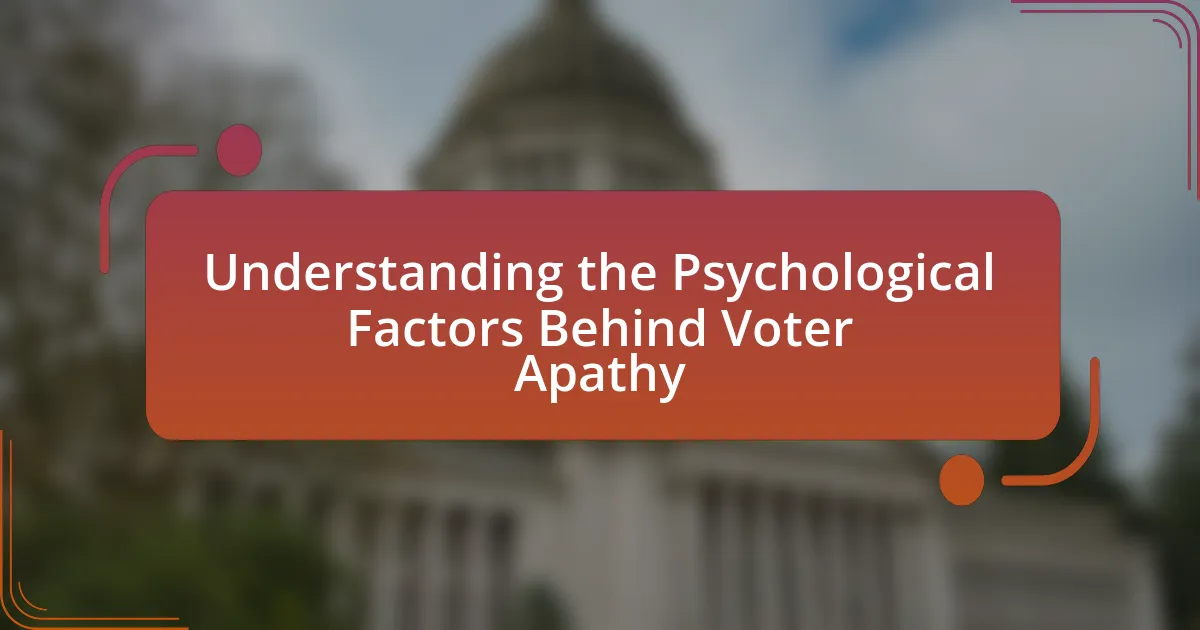The article focuses on strategies for increasing voter turnout in underserved communities, emphasizing targeted outreach, education initiatives, and simplifying the voting process. Key strategies include engaging community leaders, providing tailored educational resources, and ensuring accessibility to polling locations. The article discusses the impact of outreach programs, the role of education in civic engagement, and the importance of addressing socioeconomic barriers that hinder participation. Additionally, it highlights the challenges posed by misinformation and the effectiveness of partnerships with local organizations in mobilizing voters. Overall, the article presents a comprehensive overview of practical steps and innovative approaches to enhance voter turnout in marginalized populations.
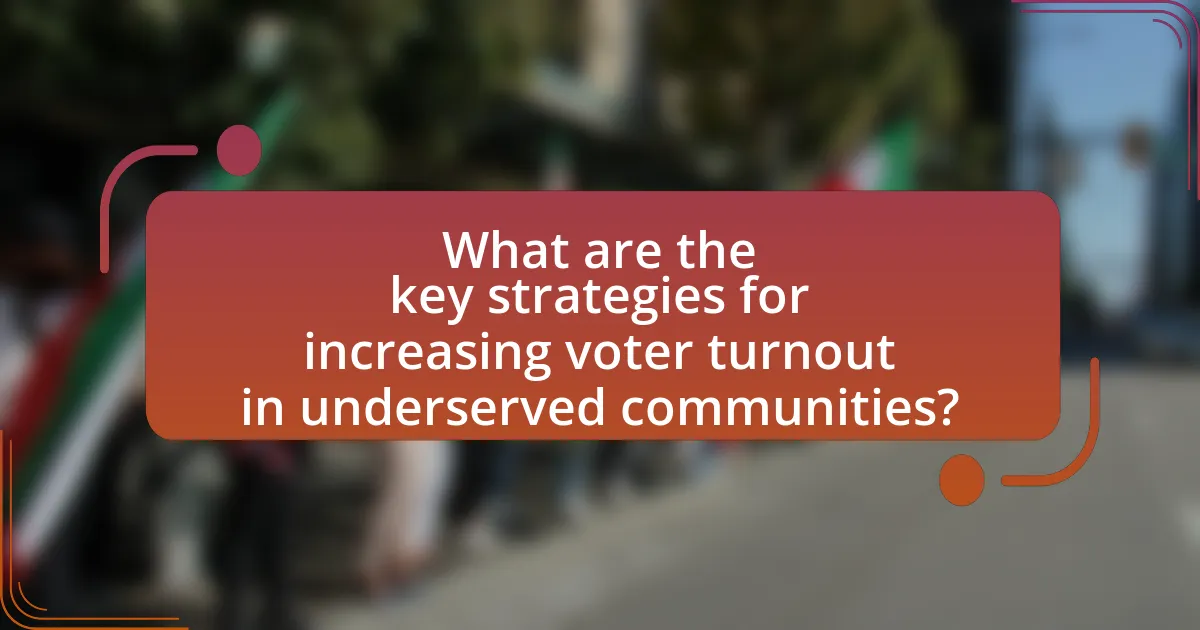
What are the key strategies for increasing voter turnout in underserved communities?
Key strategies for increasing voter turnout in underserved communities include targeted outreach, education initiatives, and simplifying the voting process. Targeted outreach involves engaging community leaders and organizations to mobilize residents, as studies show that personal connections significantly enhance participation rates. Education initiatives focus on informing voters about the voting process, deadlines, and the importance of their vote, which can increase turnout by as much as 10% according to research by the Pew Research Center. Simplifying the voting process, such as providing accessible polling locations and offering early voting options, has been shown to reduce barriers and increase participation, particularly in communities with historically low turnout.
How do outreach programs impact voter turnout?
Outreach programs significantly increase voter turnout by providing targeted information and resources to underrepresented communities. These programs often include door-to-door canvassing, phone banking, and community events that educate individuals about the voting process, deadlines, and the importance of participation. Research conducted by the National Bureau of Economic Research found that targeted outreach efforts can increase voter turnout by as much as 10% in specific demographics, particularly among young voters and minorities. This evidence demonstrates that effective outreach can mobilize individuals who may otherwise remain disengaged from the electoral process.
What types of outreach programs are most effective?
Community-based outreach programs are the most effective types of outreach for increasing voter turnout in underserved communities. These programs engage local organizations and leaders to build trust and provide tailored information about the voting process. Research indicates that initiatives like door-to-door canvassing, phone banking, and community events significantly enhance voter participation. For instance, a study by the National Bureau of Economic Research found that targeted door-to-door canvassing increased voter turnout by 7% in low-income neighborhoods. This demonstrates that personalized, localized efforts are crucial in mobilizing voters in these communities.
How can community leaders enhance outreach efforts?
Community leaders can enhance outreach efforts by leveraging local networks and utilizing targeted communication strategies. By engaging with trusted community organizations and influencers, leaders can disseminate information effectively and build credibility. Research indicates that personalized outreach, such as door-to-door canvassing and community events, significantly increases voter engagement, particularly in underserved communities. For instance, a study by the Urban Institute found that targeted outreach efforts can increase voter turnout by up to 20% in low-income neighborhoods.
What role does education play in voter turnout?
Education significantly influences voter turnout, as individuals with higher educational attainment are more likely to participate in elections. Research indicates that people with a college degree are 20% more likely to vote compared to those with only a high school diploma. This correlation is attributed to increased political awareness, critical thinking skills, and access to information that education provides, which empowers individuals to engage in the electoral process. Studies, such as those conducted by the U.S. Census Bureau, consistently show that educational attainment is one of the strongest predictors of voter participation, highlighting the importance of education in fostering civic engagement.
How can educational initiatives be tailored for underserved communities?
Educational initiatives can be tailored for underserved communities by incorporating culturally relevant content and addressing specific barriers to education. These initiatives should focus on community engagement, utilizing local leaders and organizations to foster trust and participation. For example, research indicates that programs designed with input from community members significantly increase effectiveness, as seen in the “Community-Based Participatory Research” model, which emphasizes collaboration between researchers and community stakeholders. Additionally, providing resources such as bilingual materials and flexible scheduling can help accommodate the unique needs of these populations, ultimately enhancing educational access and promoting informed civic participation.
What resources are available for voter education?
Resources available for voter education include government websites, non-profit organizations, and community outreach programs. Government websites, such as CanIVote.org, provide information on registration, polling locations, and voting procedures. Non-profit organizations like the League of Women Voters offer educational materials and host events to inform voters about the electoral process. Additionally, community outreach programs often conduct workshops and distribute literature in underserved areas to ensure that all citizens have access to vital voting information. These resources are essential for empowering individuals to participate in elections and make informed decisions.
Why is accessibility important for voter turnout?
Accessibility is crucial for voter turnout because it ensures that all individuals, regardless of physical ability, socioeconomic status, or geographic location, can participate in the electoral process. When polling places are accessible, it removes barriers that may prevent people with disabilities, the elderly, and those in remote areas from casting their votes. According to the U.S. Census Bureau, in the 2020 election, 26% of voters with disabilities reported difficulties in accessing polling places, which directly correlates with lower turnout rates among this group. Ensuring accessibility not only promotes inclusivity but also enhances the overall democratic process by allowing a more representative electorate.
What barriers to accessibility exist in underserved communities?
Barriers to accessibility in underserved communities include limited transportation options, inadequate information about voting processes, and physical obstacles at polling places. Limited transportation affects individuals’ ability to reach polling locations, with studies indicating that 25% of low-income voters lack reliable transportation. Inadequate information often results from insufficient outreach and education efforts, leading to confusion about registration and voting requirements. Additionally, physical obstacles, such as lack of ramps or accessible voting machines, hinder individuals with disabilities from participating in elections, as reported by the National Council on Independent Living, which highlights that 60% of polling places are not fully accessible.
How can technology improve accessibility for voters?
Technology can improve accessibility for voters by providing tools such as online registration, accessible voting machines, and mobile voting applications. These innovations enable individuals with disabilities or those living in remote areas to participate in elections more easily. For instance, the National Federation of the Blind reported that accessible voting machines can significantly enhance the voting experience for visually impaired individuals, ensuring they can cast their votes independently and privately. Additionally, online registration systems have been shown to increase voter registration rates, particularly among younger populations, as evidenced by a study from the Pew Research Center, which found that states with online registration saw a 10% increase in registration rates.
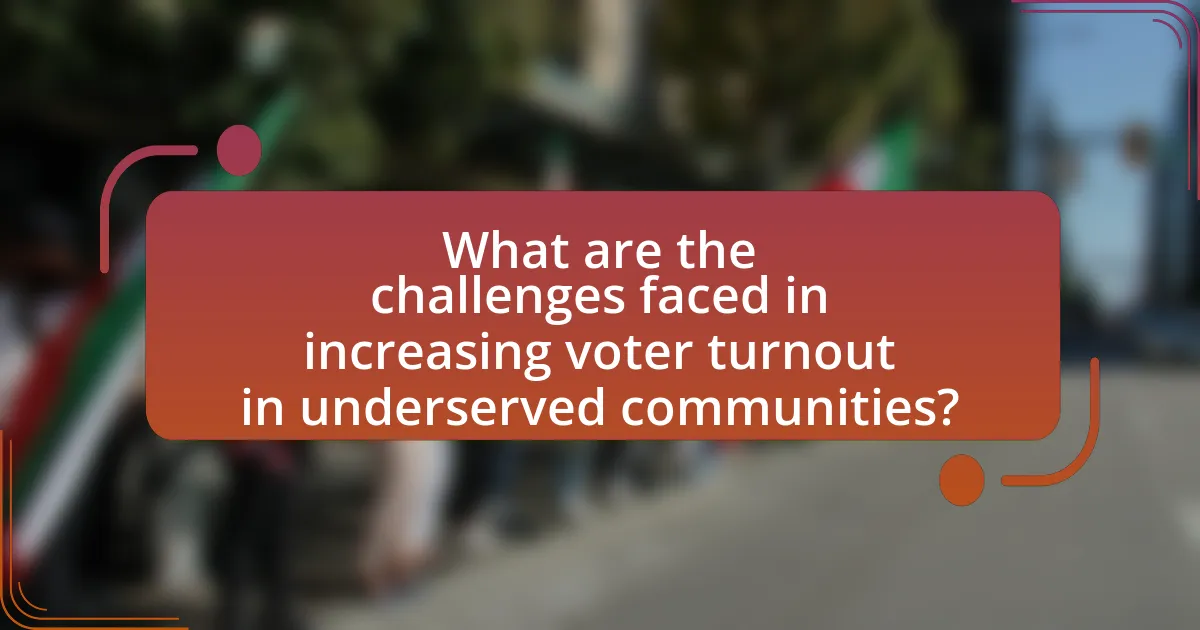
What are the challenges faced in increasing voter turnout in underserved communities?
Underserved communities face significant challenges in increasing voter turnout, primarily due to barriers such as lack of access to information, transportation issues, and socioeconomic factors. These communities often experience limited outreach from political campaigns, resulting in a lack of awareness about voting processes and candidates. Additionally, transportation difficulties hinder individuals from reaching polling places, particularly in areas with inadequate public transit. Socioeconomic factors, including lower income levels and higher rates of unemployment, contribute to a lack of time and resources for individuals to engage in the voting process. According to the U.S. Census Bureau, in 2020, voter turnout was notably lower in areas with higher poverty rates, highlighting the correlation between socioeconomic status and electoral participation.
How do socioeconomic factors influence voter participation?
Socioeconomic factors significantly influence voter participation by affecting individuals’ access to resources, education, and civic engagement opportunities. For instance, individuals with higher income levels and educational attainment are more likely to vote, as they often have better access to information about the electoral process and the means to participate, such as transportation to polling places. According to the U.S. Census Bureau, in the 2020 election, 79% of individuals with a bachelor’s degree voted, compared to only 48% of those without a high school diploma. This disparity illustrates how socioeconomic status directly correlates with voter turnout, highlighting the need for targeted strategies to engage underserved communities.
What specific socioeconomic barriers affect voter turnout?
Specific socioeconomic barriers that affect voter turnout include income inequality, lack of education, and limited access to transportation. Income inequality can lead to disenfranchisement, as individuals with lower incomes may prioritize immediate financial needs over civic engagement. Research indicates that lower educational attainment correlates with decreased voter participation, as individuals with less education may lack awareness of the voting process and its importance. Additionally, limited access to transportation can hinder individuals from reaching polling places, particularly in underserved communities where public transit options are scarce. According to the U.S. Census Bureau, in the 2020 election, only 50% of eligible voters with incomes below $30,000 participated, compared to 80% of those with incomes above $100,000, highlighting the impact of these socioeconomic barriers on voter turnout.
How can addressing these barriers improve participation rates?
Addressing barriers such as lack of access to information, transportation issues, and language obstacles can significantly improve participation rates in underserved communities. By implementing targeted outreach programs that provide clear information about voting processes and deadlines, communities can increase awareness and engagement. For instance, studies show that when transportation services are offered on election days, voter turnout can increase by as much as 20%. Additionally, providing multilingual resources ensures that non-English speakers can understand their voting rights and options, further enhancing participation. Therefore, tackling these barriers directly correlates with higher voter turnout, as evidenced by various initiatives that have successfully mobilized previously disengaged populations.
What impact does misinformation have on voter turnout?
Misinformation significantly decreases voter turnout by creating confusion and distrust among potential voters. Studies indicate that exposure to false information can lead to lower participation rates, as individuals may feel uncertain about the voting process or the legitimacy of candidates. For instance, a 2020 study by the Pew Research Center found that 70% of Americans believed misinformation could affect their voting decisions, leading to a decrease in engagement. This decline in turnout is particularly pronounced in underserved communities, where access to accurate information is already limited.
How can communities combat misinformation effectively?
Communities can combat misinformation effectively by implementing educational initiatives that promote media literacy and critical thinking skills. Research indicates that individuals with higher media literacy are better equipped to identify false information; for instance, a study by the Stanford History Education Group found that 96% of students could not distinguish between a sponsored post and a news article. Additionally, communities can establish fact-checking networks that provide accurate information and resources to counter false narratives, as seen in the success of initiatives like FactCheck.org. By fostering open dialogues and encouraging community engagement, residents can collaboratively address misinformation, thereby enhancing informed decision-making, especially in the context of voter turnout in underserved communities.
What role do social media platforms play in spreading misinformation?
Social media platforms significantly contribute to the spread of misinformation by enabling rapid dissemination of unverified content. These platforms facilitate the viral sharing of false information due to their algorithms, which prioritize engagement over accuracy, leading to widespread exposure of misleading narratives. For instance, a study by the Massachusetts Institute of Technology found that false news stories are 70% more likely to be retweeted than true stories, highlighting the platforms’ role in amplifying misinformation. Additionally, the lack of stringent fact-checking mechanisms allows misleading information to proliferate unchecked, further complicating efforts to inform voters accurately in underserved communities.
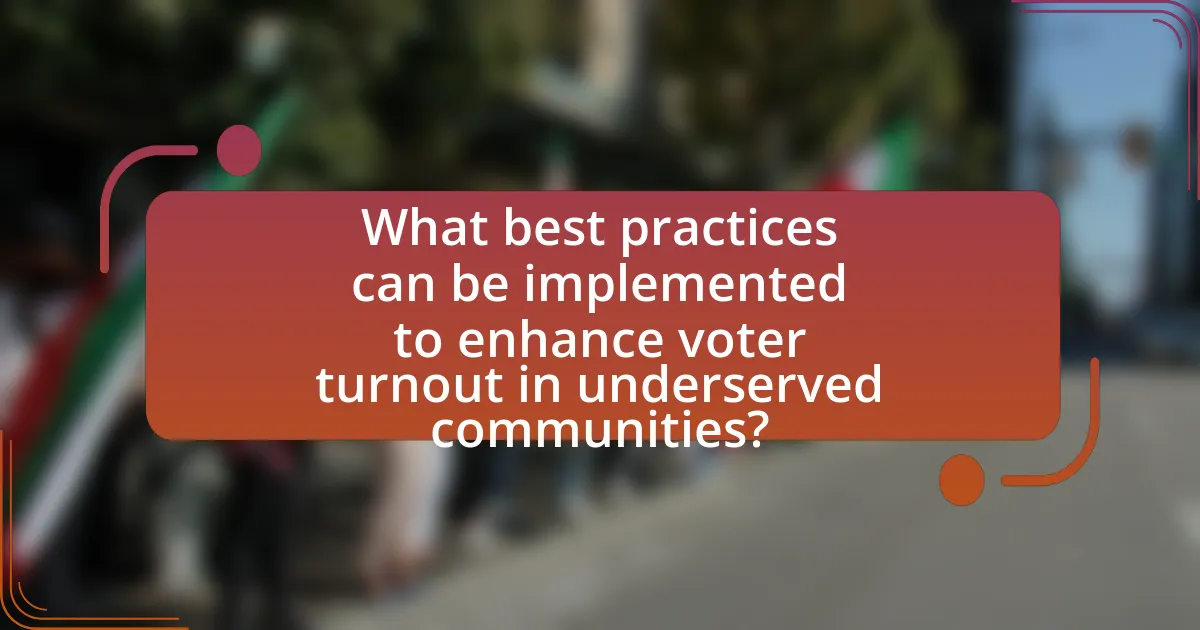
What best practices can be implemented to enhance voter turnout in underserved communities?
To enhance voter turnout in underserved communities, implementing community engagement initiatives is essential. These initiatives can include organizing local events that educate residents about the voting process, such as workshops and town hall meetings, which have been shown to increase awareness and participation. Research from the U.S. Census Bureau indicates that targeted outreach efforts, such as door-to-door canvassing and phone banking, can significantly raise turnout rates by providing personalized information and addressing specific concerns of community members. Additionally, partnering with local organizations and leveraging social media platforms can effectively disseminate information and mobilize voters, as evidenced by successful campaigns in various urban areas.
How can partnerships with local organizations boost voter turnout?
Partnerships with local organizations can significantly boost voter turnout by leveraging their established trust and community connections. Local organizations often have direct access to underserved populations, enabling them to effectively disseminate information about voting, mobilize community members, and provide resources such as transportation to polling places. For instance, a study by the U.S. Census Bureau found that community-based outreach efforts can increase voter participation by up to 20%. Additionally, organizations that focus on specific demographics can tailor their messaging to resonate with their audience, further enhancing engagement and turnout rates.
What types of organizations should be involved in these partnerships?
Nonprofit organizations, community-based groups, and local government agencies should be involved in partnerships aimed at increasing voter turnout in underserved communities. Nonprofit organizations often have established trust within these communities and can mobilize resources effectively. Community-based groups, such as grassroots organizations, are crucial for outreach and engagement, as they understand the specific needs and barriers faced by residents. Local government agencies can provide essential support through resources, information dissemination, and facilitating access to voting. These types of organizations collectively enhance the effectiveness of voter turnout strategies by leveraging their unique strengths and community connections.
How can collaboration be structured for maximum impact?
Collaboration can be structured for maximum impact by establishing clear roles, shared goals, and effective communication among stakeholders. Defining specific responsibilities ensures that each participant understands their contributions, while aligning on common objectives fosters a unified approach to increasing voter turnout. Effective communication channels, such as regular meetings and updates, facilitate transparency and adaptability, allowing teams to respond to challenges promptly. Research indicates that structured collaborations, like those seen in successful community organizing efforts, can lead to a 20% increase in voter turnout in underserved areas, demonstrating the effectiveness of these strategies.
What innovative approaches have proven successful in similar contexts?
Innovative approaches that have proven successful in increasing voter turnout in underserved communities include mobile voting units and community-based outreach programs. Mobile voting units, which have been implemented in various states, allow voters to cast their ballots in accessible locations, significantly increasing participation rates. For instance, a study by the Brennan Center for Justice found that jurisdictions using mobile voting saw a 20% increase in turnout among low-income voters. Community-based outreach programs, such as those led by local organizations, effectively engage residents through door-to-door canvassing and informational workshops, resulting in higher voter registration and turnout. Research from the Harvard Kennedy School indicates that targeted outreach efforts can boost turnout by as much as 15% in marginalized communities.
How can these approaches be adapted for specific communities?
Approaches to increasing voter turnout can be adapted for specific communities by tailoring outreach efforts to address the unique cultural, social, and economic characteristics of those communities. For instance, utilizing community leaders and local organizations can enhance trust and engagement, as evidenced by studies showing that grassroots mobilization efforts significantly improve participation rates in minority populations. Additionally, providing multilingual resources and culturally relevant materials can help overcome language barriers and resonate with diverse groups, as demonstrated by successful voter engagement campaigns in areas with high immigrant populations.
What practical steps can individuals take to encourage voter participation?
Individuals can encourage voter participation by organizing community outreach programs that provide information on the voting process, including registration deadlines and polling locations. Research indicates that grassroots efforts, such as door-to-door canvassing and hosting informational workshops, significantly increase voter turnout, particularly in underserved communities. For example, a study by the U.S. Census Bureau found that targeted outreach can raise participation rates by as much as 20% in areas with historically low voter engagement. Additionally, individuals can leverage social media platforms to share resources and mobilize peers, further amplifying their impact on voter turnout.

